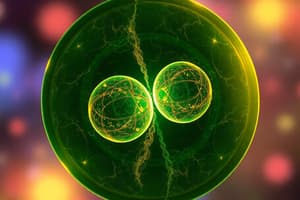Podcast
Questions and Answers
What is the primary outcome of mitosis?
What is the primary outcome of mitosis?
- Production of gametes with half the chromosome number
- Formation of one daughter cell
- Generation of cells with varied chromosome numbers
- Creation of two identical daughter cells (correct)
Which organelle is responsible for regulating the passage of substances in and out of the cell?
Which organelle is responsible for regulating the passage of substances in and out of the cell?
- Cytoplasm
- Cell membrane (correct)
- Nucleus
- Mitochondria
What is true about passive transport in cells?
What is true about passive transport in cells?
- It involves movement against the concentration gradient
- It includes processes like diffusion and osmosis (correct)
- It requires energy input to occur
- It can only occur in the presence of specific transport proteins
What type of cell division produces sex cells?
What type of cell division produces sex cells?
Which statement accurately describes active transport?
Which statement accurately describes active transport?
Flashcards are hidden until you start studying
Study Notes
Cell Division
- Cell division is the mechanism by which a parent cell splits into two or more daughter cells.
- Mitosis generates two daughter cells, each with an identical chromosome number to the parent cell.
- Meiosis results in gametes (sex cells) that contain half the chromosome count of the parent cell, facilitating sexual reproduction.
Cell Structure
- Cells represent the fundamental building blocks of all living organisms, responsible for both structure and function.
- Key organelles include:
- Nucleus: houses genetic material and regulates cell activities.
- Mitochondria: known as the powerhouse of the cell, generates energy through cellular respiration.
- Cytoplasm: gel-like substance where organelles are suspended and metabolic processes occur.
- The cell membrane encases the cell, controlling the entry and exit of substances, thus maintaining homeostasis.
Cell Transport
- Cell transport involves the movement of ions and molecules across the cell membrane, crucial for maintaining cellular function.
- Two primary transport types:
- Passive transport: substances move across the membrane without energy expenditure, utilizing processes like diffusion and osmosis.
- Active transport: requires energy (ATP) to move substances against their concentration gradient, facilitated by specific transport proteins in the cell membrane.
Conclusion
- Understanding cell division, structure, and transport allows Year 9 students to appreciate the complexities and functionalities inherent in living organisms.
Studying That Suits You
Use AI to generate personalized quizzes and flashcards to suit your learning preferences.





